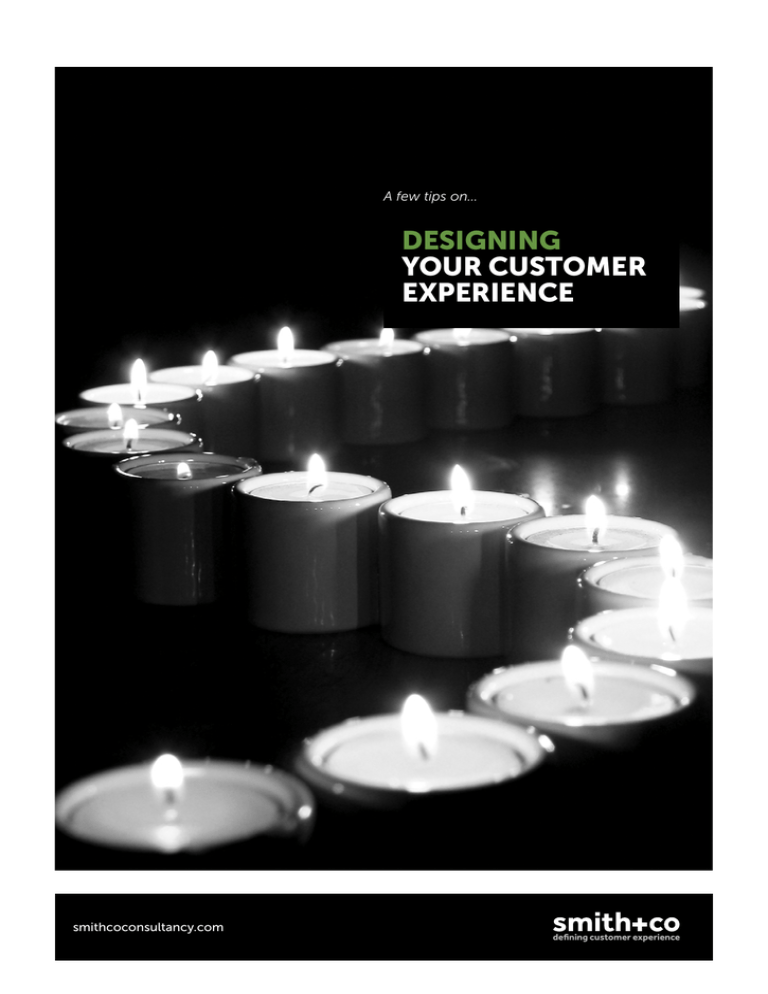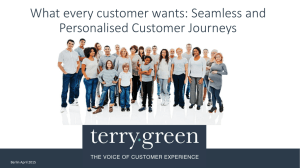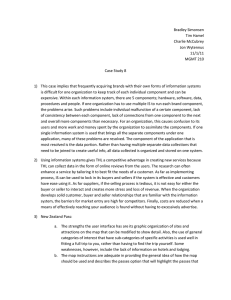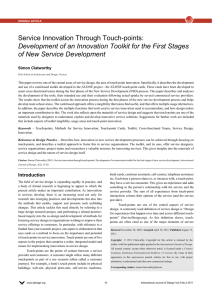
A few tips on…
Designing
your customer
experience
smithcoconsultancy.com
“
We lay the stage
for each guest’s
own piece of
interactive theatre.
It’s about creating
an environment
and atmosphere
that is quite special
and then acting as
facilitators for
our guests’ own
out-of-the-ordinary
experience
Ho Kwon Ping
Chairman
Banyan Tree Hotels and Resorts
smithcoconsultancy.com
DESIGNING YOUR CUstomer experience
Customer experience design
is not about scripting your people,
or prescribing exact behaviours
at every point.
It’s about creating the right environment, with the right
‘back-stage’ support and technology and then enabling
your people to facilitate an experience that will be valued
by your customers.
We advocate a concept called ‘Loose/Tight’. Most organisations are
very ‘loose’ when it comes to what their brand stands for and the kind of
experience they wish customers to have, but very ‘tight’ when it comes
to telling employees how to behave.
Brands that deliver great experiences usually reverse these two, being
very ‘tight’ about what the brands stands for and the experience they wish
to create but quite ‘loose’ in allowing their people freedom in how they
satisfy their customers.
But how can you design a customer experience that achieves this?
Can customer experience even be designed?
DESIGNING YOUR CUstomer experience
“
You cannot
design a customer
experience because
it is whatever the
customer perceives
it to be
This quote by Geek Squad founder, Robert Stephens, raises
a good question. If you can’t design your customer experience,
what can you do to influence it? For Stephens, it’s all about hiring
the right people. But it’s also about being intentional about HOW
those people deliver that experience so it differentiates your brand,
is consistent and delivers value to your target customers.
So when we talk about ‘designing’ customer experience, we refer to
designing a framework that enables organisations to do this. This framework
details the touch-points where you need to differentiate and the ways in which
your products, processes and behaviours must be distinctive to deliver value
to your target customers.
There is no ‘one size fits all’ approach as to how you do this, but here we offer
a few tips to help you on your way.
Before you begin, start with the right foundation
Many organisations begin to think about customer experience improvements
without first creating the right context for doing so.
So before you begin, be clear on the following three things:
• What your target customers expect and how you are performing
against these expectations.
• The customer values that drive retention and advocacy.
• A clearly articulated brand promise that will deliver this value and differentiate
you from your competitors.
If you don’t have this degree of clarity, take a look at our guides to customer
experience research and brand promise definition.
smithcoconsultancy.com
DESIGNING YOUR CUstomer experience
“
Don’t judge a man
until you have
walked two moons
in his moccasins
Native American proverb
Until you’ve experienced the actual ‘journey’ your customer
takes, you can’t begin to empathise with what he or she goes
through. So think of the journey from the customer’s
perspective, not the organisation’s
Map the experience from beginning
to end including social media
engagement and digital interactions.
If possible map one touchline covering
the entire experience but if this is too
complex (as in the case of some b2b
businesses), map a touchline for each
key customer interaction. As a rule,
we rarely work with more than eight to
twelve major touch-points. If you have
a lot more than this you are probably
mapping your organisational processes
rather than the customer experience.
Think also beyond the accepted
beginning and past the perceived end.
We often define the customer journey
too narrowly because we think of it in
functional terms. This is a journey so
it’s not just the sales experience that
counts. For many brands, the customer
journey is on-going, with after-sales
care and loyalty efforts to foster and
build the relationship.
The experience
you deliver to your
customers every
day, through every
transaction, direct
and indirect either
builds value for your
brand or destroys it.
The sum of all these
touch-points is the
customer experience
that defines your
organisation.
smithcoconsultancy.com
Identify the pain or stress points
Note inefficiencies, redundancies
or inconsistencies in how customers
experience your brand. Consider your
brand promise and how well you
deliver it at each point in the touchline.
Ensure you think about your most
valuable customers and their top
expectations – and what they will be
experiencing and feeling at each
touch-point.
Identify opportunities
In order to streamline and
improve the experience, look also
for the ‘cracks’ or hand-offs between
existing touch-points e.g. the interval
between making a purchase on-line
and the actual delivery of the goods.
Also look ‘up-stream’ and ‘down-stream’
along the customer journey for those
touch-points that are ignored by
your competitors.
Often, the biggest opportunity to
differentiate is on those touch-points
that are not even on the radar screen
of your competitors.
Identify your ‘hallmark’ touch-points
These are the ones that will really
distinguish your brand and emotionally
engage your customers. They are the
touch-points that you need to
‘over-index’.
One mistake brands often make
is thinking that they need to focus
on delivering a great experience at
every touch-point. Unless you are a
Ritz-Carlton and can price accordingly
– don’t. So ‘dial-up’ the experience
only at those touch-points where you
choose to differentiate and are willing
to invest the resources to create a
‘wow’ experience.
Outline what you want to
happen at each touch-point
Clarify what you want your
customers to experience and feel.
What does this look like in terms of
how you want your people to interact
with them? How do they need to
behave in order to reduce the pain,
increase the pleasure and deliver your
brand promise? The pleasure peaks
should align with the hallmarks that
you have chosen.
Implications for process
product and people
Designing your experience is one
thing; implementing it is another.
The next step to think about is the
implication for your people, processes
and products – and how you align
these to deliver the experience.
Get your HR and Operations people
involved as part of the design process.
They need to understand it, commit to
it and be given the resources to do it.
DESIGNING YOUR CUstomer experience
Mapping the touch-points
Let’s take a look at a couple of ways you could map the journey…..
Luxury retail store - physical touchpoints
Entrance
After-sale
Welcome
Goodbye
Present
the product
Browse
Engage/
approach
Purchase
Experience
the product
Digital touchpoints
Search
Digital billboard
Newsletter
Landing page
Blog
Viral email
Mobile
IM/Chat
3rd party sites
Online aids
awareness
consideration
Word-of-mouth
purchase
service
Call center IVR
PR
Radio
TV
Print
Outdoor
smithcoconsultancy.com
Blog
loyalty
Promotion
on invoice
Physical touchpoints
Managed touchpoint
Image taken from b2bstories.com
Email
Website
Unmanaged touchpoint
DESIGNING YOUR CUstomer experience
CASE STUDY
VISION
TO BE THE
PEOPLE’S CHAMPION
mISSION
BUSTING CARTELS
AND SUPPORTING
THE UNDERDOG
VALUES
FUN, ENTERTAINMENT,
IRREVERENECE,
INNOVATION
Journey-mapping in action
Let’s take the experience of a typical airline passenger.
We start by showing the customer touch-points and the
typical sort of pressures that many of us face when flying.
Now let’s look at how Virgin Atlantic has looked up-stream and down-stream
along the journey to re-design the ‘Upper-Class’ customer experience in order
to increase the pleasure, decrease the pain and differentiate from competitors.
’Notice the design features (highlighted in bold) at the bottom. These are the
brand hallmarks where Virgin chooses to ‘over-index’ to deliver their promise.
Needless to say, we’ve greatly simplified it to bring out the learning and
protect the confidentiality of Virgin Atlantic!
Customer
touch-points
Getting
to airport
Check-in
Comfort
until flight
In-flight
comfort
Arrival
Getting to
destination
Customer
experience
issues
Stressful
Long,
frustrating lines
Want to work
Planes are
uncomfortable
Unkempt
Traffic
Un-showered
Unfamiliar place
Parking
Luggage
Want to relax
Unnecesasary
(Only necessary
to airline)
Long time in seat
Clothes a mess
Boredom
Customer experience
Design
features
Transport
to airport
provided
Driver
handles
luggage
Drive-through
check-in
Clubhouse
with Wi-Fi
Airline knows
where you are
Massage/spa
Sound room
Driving range
Skiing Machine
smithcoconsultancy.com
Full sleeper seats
Arrival valet
Mood lighting
18 showers
Gradual dawn
Makeup/shave
Bar
Heated floors
You decide meals
Clothes pressed
Hot & cold
breakfast
Chauffeured
delivery to
destination
Comfortable
ride doorto-door
Knowledgeable
local driver
DESIGNING YOUR CUstomer experience
A few other
things to
think about…
Don’t gold-plate your
customer experience
Customer experience is a
neutral term and does not imply
gold-plated service. Ritz-Carlton
offers a great customer experience
but so too does Premier Inn. Yet their
business models and price points
are very different and delivered in
distinctive ways. Be careful not to
upgrade your customer experience
beyond the point that target customers
want and are willing to pay for, simply
because it is what you value.
Focus on the dollars,
not the dimes
There is a saying in the US:
“Don’t nickel and dime me”, which
means to accumulate money in
small amounts. There are examples
of this in many areas of customer
service and it is one of the practices
that drives many consumers crazy.
A classic example is when you pay
mega dollars to stay in a luxurious
5-star hotel and yet still have to pay
your $12 a day for internet access.
What behavioural science tells us is
that the customer’s memory of an
experience is formed at every touchpoint with a brand. Generally speaking,
the greater the number of pleasurable
or ‘branded’ touch-points, the more
positive the experience is. When you
‘nickel and dime’ customers you create
little moments of pain that jar with the
customer and remind them how much
this is costing, and if these happen at
the end of the experience that is what
they will likely remember. Don’t surprise
your customer with add-on costs.
smithcoconsultancy.com
Feedback is a touchpoint
How, and when you ask customers for feedback – and respond to it – are
important touch-points. Whether it’s through a survey, or a review on Trip Advisor
or a comment within social media, make sure you create a touch-point that enables
you to influence that experience of your brand, but without it being onerous for
the customer.
And five further ‘rules’ for creating a great experience
Behavioural scientists Richard Chase and Sriram Dasu identified five rules to
ensure that customers focus on the high points of their experience and overlook
the low points. In our summary below, for simplicity we’ve focused on the hotel
industry. With a bit of creative, bold thinking, the same principles can be applied
effectively to any sector.
Finish strong
Finish on a high – do something
unexpected at the end of the
experience. For example, a small
gift given at the point of check-out.
This helps to create a positive
moment at the very point you are
asking the customer to part with
their cash.
Build customer commitment
through choice
Give guests full information about
your charges (like water-sports) on
your web site so they are transparent
and expected. Guests can then make
informed choices about the package
they need and, most importantly,
wont be surprised by them.
Get bad experiences over with early
If customers have to do something
onerous, get it out of the way as
quickly as possible. In the case of
hotels, pre-register guests online so
that their first experience of the hotel
is not one of lining up at the front
desk and filling in a registration form
with exactly the same information
they provided when they booked
or stayed last time.
Stick to rituals
Create on-brand rituals that
customers associate with their
stay with you. For example, a trait
of the Banyan Tree Resorts each
evening is to leave a little locally
made, handcrafted gift as part of
the turn-down service rather than
the ubiquitous chocolate. Not only
does this create a little moment
of pleasure but also serves to
highlight their support for the
local community.
Segment pleasure,
combine the pain
Spread the pleasure along the
touch-line. So provide those little
touches of fresh cookies served
with coffee, cold face towels on
the beach etc. They cost very little
but create little ‘spikes’ of pleasure.
Combine the ‘pain’ by bundling
internet and other facility charges
into the room rate so that you
experience them in one step rather
than every time you wish to
use them.
“
It is often the little things
that your customers
remember - especially
how you made them feel.
And that more often comes
from your people rather
than your product
DESIGNING YOUR CUstomer experience
One final note
Search the internet on the ‘how to’ of customer experience
design, and you will find hundreds of methodologies, models,
academic papers, theories and frameworks.
There is however nothing like your own experience as a customer to draw
on when thinking about the experience you want to create for your customers.
As you interact with brands every day, in whatever format, be conscious of what
you are experiencing - good or bad. Once you and your team start opening
yourself up to experience in this way, experience design becomes much more
insightful, intuitive, instinctive and far more exciting.
Customer experience design is part science and part art. The important thing is
to apply rigour to how you design, but be bold enough to let your instinct guide
your creativity. So don’t let your agency design the experience alone, (nor your
product engineers) otherwise you will only get – and create - half the story.
Customer experience design requires both sides of the brain to be engaged.
©smith+co 2013. All rights reserved
smithcoconsultancy.com






